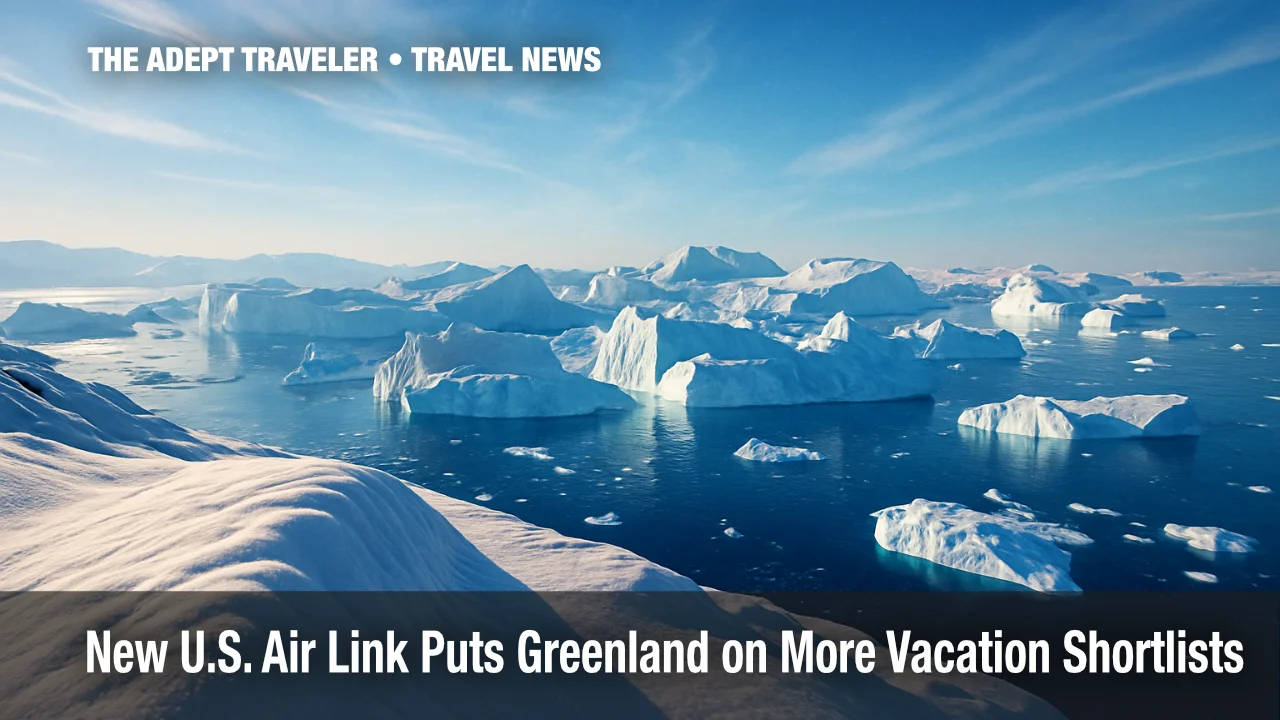Greenland Tourism Heats Up with Newark-Nuuk Nonstop Flight

Greenland tourism is having a moment. A twice-weekly Newark-Nuuk nonstop flight, a strategic tourism plan that reaches to 2035, and a surge in boutique expedition cruises are transforming the world's largest island from dream trip to attainable Arctic vacation. As local leaders frame growth around Inuit culture and environmental care, would-be visitors can now reach Nuuk in just over four hours-and start whale-watching, glacier hiking, or village-hopping the same day.
Key Points
- First U.S.-Greenland nonstop flights launch June 14, 2025, via United Airlines.
- About 150,000 visitors arrived by cruise in 2024, triple pre-pandemic levels.
- Visit Greenland's 2025-2035 strategy aims for community-owned, low-impact tourism.
- New airports in Nuuk and Ilulissat support larger jets and winter operations.
- Why it matters: Faster access plus careful planning could balance economic gains with Arctic preservation.
Greenland Tourism Snapshot - How It Works
Greenland is an autonomous Danish territory stretching 1,000 miles above the Arctic Circle. Summer brings 24-hour daylight, iceberg-filled fjords, and temperatures hovering in the 40s °F, perfect for soft-adventure travelers who want uncrowded trails and Inuit cultural encounters. Limited roads mean most itineraries rely on Dash-8 hops, coastal ferries, or expedition ships. Peak season runs June through September; winter aurora trips spike from February to April. Prices skew high-expect hotel doubles from DKK 2,000 (about USD $290) nightly-but the new jet service and fresh airport infrastructure promise more competitive packages.
Greenland Tourism Background - Why It Matters
Tourism contributed roughly 4.9 percent of Greenland's GDP in 2024, but officials long viewed the sector as a diversification tool rather than a mass-market cash cow. Earlier efforts stalled under thin air links that forced U.S. travelers through Reykjavík or Copenhagen. Political headlines in 2019, when then-President Trump mused about "buying" Greenland, inadvertently boosted global awareness. Local operators seized the attention to pitch small-group trips focused on ice, wildlife, and Inuit history-assets impossible to relocate and highly sensitive to climate change. The result: visitor interest soared, yet residents demanded growth that protects fragile ecosystems and hands decision-making to Greenlanders.
Greenland Tourism Latest Developments
Greenland's tourism story is shifting from potential to progress.
Direct U.S. Flights Land in Nuuk
On June 14, 2025, United Airlines becomes the first American carrier to touch down in Greenland, operating Newark-Nuuk service every Tuesday and Saturday southbound and Wednesday and Sunday northbound. Boeing 737 MAX 8 aircraft will cover the 1,780-mile route in just over four hours, slashing journey times by a full travel day. The new airport outside Nuuk features a 7,200-foot runway, wide-body-ready stands, and all-weather ILS, upgrades that anchor Greenland's push for year-round tourism.
Cruise Calls Surge Along the Coast
Expedition and small-ship lines scheduled roughly 500 port calls in 2024, bringing an estimated 150,000 passengers-triple 2019 figures. Ports like Qaqortoq, Ilulissat, and Sisimiut now employ local guides, craftspeople, and tender crews. Greenland's Maritime Authority tightened environmental guidelines, capping daily landings in sensitive fjords and requiring low-sulfur fuels. Operators such as Hurtigruten and Quark Expeditions have begun voluntary offsets and Inuit-run shore programs to keep revenue circulating in coastal communities.
Ten-Year Strategy Charts a Community-First Path
Released in May 2025, Visit Greenland's 2025-2035 strategy anchors growth on three pillars: co-creation with residents, net-positive cultural impact, and year-round economic diversification. Goals include doubling tourism's GDP share, raising full-time industry employment to 3,500, and ensuring every new project passes a "local benefit" test. Funding channels range from micro-grants for Indigenous storytellers to public-private airport partnerships. Officials emphasize that visitor numbers will expand "measuredly," not exponentially, with strict caps in ecologically sensitive zones.
Analysis
For American travelers, the Newark-Nuuk nonstop changes everything. Door-to-door itineraries that once required two stopovers and 20 hours now fit into a long weekend, making Greenland a realistic alternative to Alaska for iceberg cruises or Iceland for volcanic landscapes. Expect introductory airfares under USD 800 round-trip and bundled packages that fold in town tours, fjord cruises, and helicopter ice-cap landings. Cruise fans should monitor small-ship operators offering early-booking perks before harbor fees rise. Independent visitors will still face high on-ground costs-limited lodging inventory drives rates-but new guesthouses and glamping pods could soften sticker shock. The main traveler takeaway: book ethical operators. Opt for companies that cap group size, hire Greenlandic guides, and follow leave-no-trace protocols. Doing so supports the island's aim to use tourism proceeds for healthcare, housing, and youth jobs rather than exporting profits abroad. Our Greenland travel guide breaks down vetted operators and sustainable itineraries.
Final Thoughts
Greenland tourism's future hinges on balanced growth: enough visitors to boost livelihoods, not so many that glaciers and Inuit culture become backdrops for selfies. If you crave an Arctic vacation that pairs raw landscapes with authentic community encounters, 2025-2026 is the sweet spot-after the flight launch but before prices climb. Reserve early, pack layers for four-season weather, and learn a few Greenlandic phrases like "qujanaq" (thank you). Most importantly, travel as a respectful guest. Greenland's grandeur will reward you in ways no postcard can capture, and your choices today help keep that magic alive for the next explorer.
